Steph W. from SEOPressor


...help you check your website and tell you exactly how to rank higher?


85
score %
SEO Score

Found us from search engine?
We rank high, you can too.
SEOPressor helps you to optimize your on-page SEO for higher & improved search ranking.
By winniewong on December 21, 2018
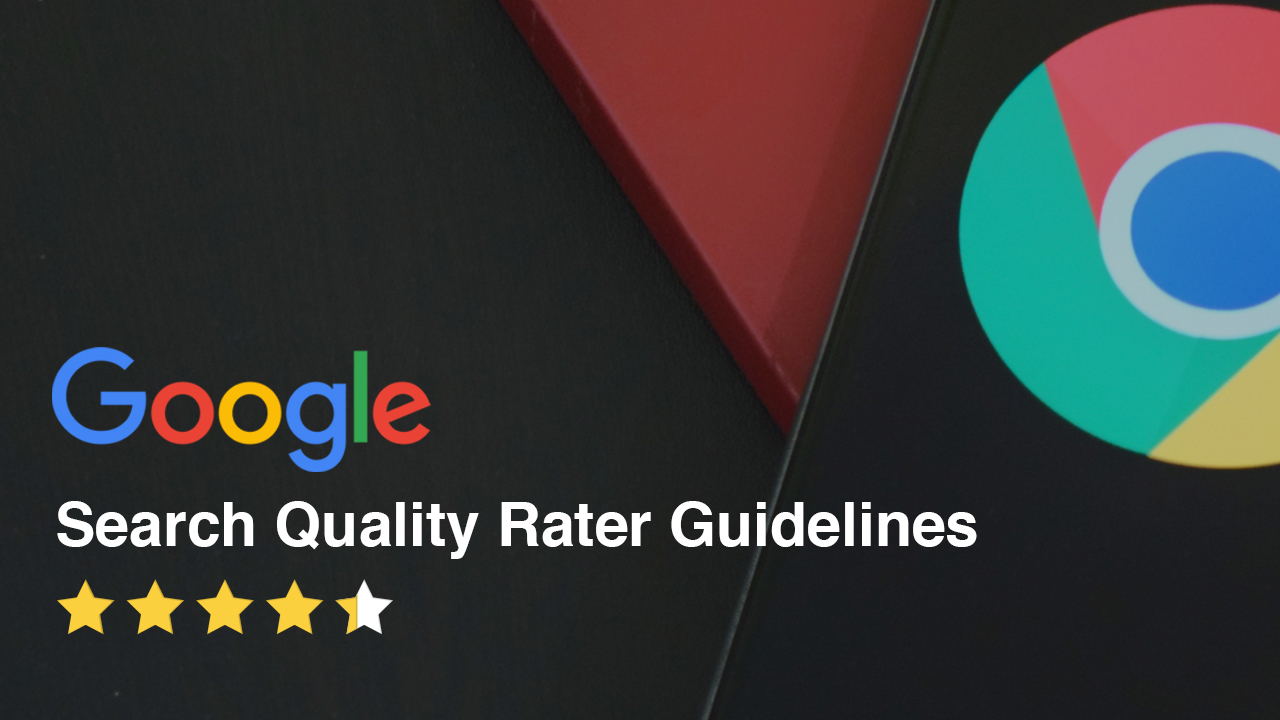
You may have heard about the Google Search Quality Raters Guidelines and let’s be blunt… it’s really thick.
The document has 168 pages that serve as the extensive guidelines for Search Quality Raters all around the world to evaluate and provide feedback to improve user search experience.
For SEO’s who have dedicated themselves to keeping up with the Google algorithm update recently, this document serves to reaffirm what you already know, with a few new updates thrown in.
For SEO novices, this serves as a further read up on Google’s preferences and the future of SEO. By following the guidelines, you can know exactly what shall be done to get your website favorable in the eyes of Google.
So let’s break it down.

Websites demonstrating a high level of expertise, authoritativeness, and trustworthiness (E-A-T) is one of the most important characteristics of high-quality content.
Keep in mind that there are high E-A-T pages and websites of all types, even gossip websites, fashion websites, humor websites, forum, and Q&A pages, etc. So, what is EAT?
Regardless of any algorithm change, in order to build a site for long-term success, you need to understand what and how E-A-T Rating works and ensure you have done all you can to meet the standards.
In most fields or topics, experts are made through study and certifications. Try to find different ways to show off your expertise on the subject but remember that it varies largely from the purpose of each website.
Having expertise is to show that you know what you’re talking about in your niche. This is especially vital for those in the medical, finance, or legal websites. Your credentials, expertise, and education should be clearly mentioned in your content.
Without a doubt, your products, site functionality, and brand integrity must be perceived highly in order to earn positive press and recommendations from experts in the appropriate industries
You may be a bit confused between the difference of expertise and authoritativeness. Let’s think of it this way:
You need to show you are an authority on the topic being discussed. This can be done by drafting content that is clear, concise, and easy to comprehend. Credentials are important, but so do reviews from actual patients and case studies.
The third and last part is trust. Always show users that they can trust the page they are on. If your users are comfortable reading, recommending and sharing the content, then trust is established.
If you’re going to ask for a name, phone number, or email address, make sure the user knows what they are doing and getting out of it.
Don’t seem like a scam to your users nor making it look like a malicious site. Return policies, guarantees, and similar information should be easily accessible. The checkout process shouldn’t be introducing fees or payments they were not expecting or warned about beforehand.
So, ask yourself is your website and content E-A-T-able by Google standards?
Read more about E-A-T here: What Is E-A-T In SEO: Keys To A Quality Website
Main Content (MC) is described by Google as “Any part of the page that directly helps the page achieve its purpose”. Basically, anything that relates to the main purpose of the page – offering news, a useful tool, a blog post – the MC is the content that fulfills this purpose.
It is stated in the guide:

Webmasters directly control the MC of the page and it can be in the form of text, images, videos, page features or user-generated content like reviews, or articles that they have added to the page.
It’s important to note that the MC should adequately satisfy the user’s query. For a page to be assigned a high page quality rating, there should be a “satisfying amount of high-quality MC”.
To be considered high-quality, your MC should be:
Supplementary Content (SC) is defined as any content that assists the MC in achieving its purpose. It is controlled by webmasters and is an important part of the user experience. Either it can help a page better achieve its purpose or it can reduce from the overall experience.

Webmasters should be asking themselves what types of supplementary content they can include by adding value to users’ experience but it should not interfere with the main content. What are some tools, resources or articles that would be helpful to the reader?
One common type of SC is navigations links that allow users to visit other parts of the website. According to Google, this can include footer info, links to related content, site navigation, features that help shoppers find similar products, etc.
**From our experience writing at SEOPressor, we find it is better to have a satisfactory amount of high-quality main content than creating a high amount of supplementary content.
However, this can only work if you create high-quality topics that cover broadly and has been optimized with long-tail keywords, like our Big Keyword Research Guide for SEO.
Contrary to popular belief that it is hard to create long-form, in-depth content, we created the guide in just 2 days, using BiQ’s Keyword Intelligence to figure out our target keyword and overall content layout and ideation.
Then perfecting it using BiQ’s Content Intelligence to make sure each and every paragraph of our content is relevant.
BiQ Content Intelligence provides you with the best content-driven strategies which are SEO-friendly. While you write in the block editor, you will also be getting interactive writing tips to aid you.
You will see your “content grade”, and keywords count that tells how relevant your article is. You’ll also quickly see if you’ve included enough keyword density.
Switch to WordScope, and you will see a list of 2- to 30 related terms to include in your content.
By doing this, it’ll further improve your content relevant to your target keyword.
You can try emulating our 2 days big content creation using BiQ by signing up for free tier access here.
Google coined the term, Your Money or Your Life Pages (YMYL) to websites if you have the potential to negatively impact users. Held to a much higher standard than a regular website, YMYL websites offer content that may affect a user’s physical and mental health or their financial well-being.
Since the update, many business types fall into the YMYL category and hence the need to maintain high-quality content. Here are some of the businesses affected:
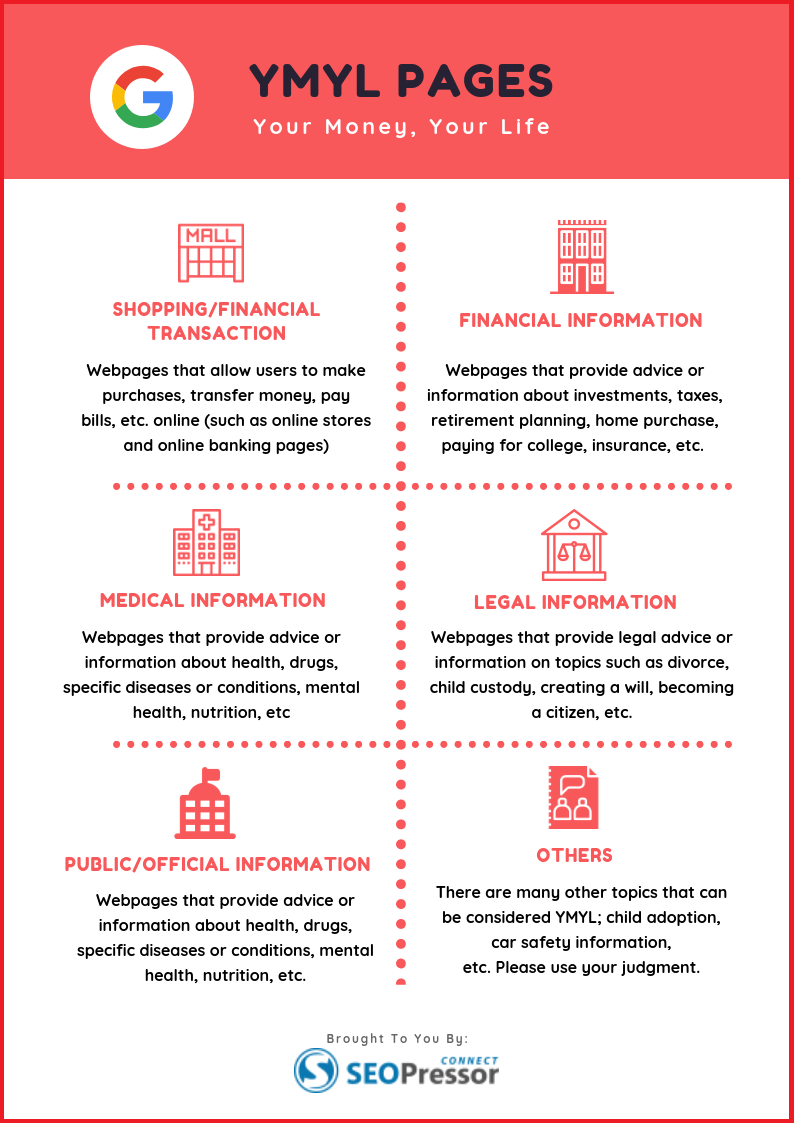
If your website belongs to one of the categories as mentioned above and if you fail to deliver high-quality information, then Google will leave you out of the top spots of SERP.
It’s no longer a secret that Google has been constantly dropping hints about how they love mobile-friendly websites. Google notes that people rely on their phones most of the time these days. The task may range from a simple one like asking for the weather, to a complex one like finding restaurants near you.
We live in an era of “now”, where we all want things immediately. This algorithm is supposed to allow us to find the information that we want as easy as possible.
See, Google has dedicated 1/4th of its quality rating document to mobile search. Sites that aren’t mobile-friendly have a 0% chance of ranking well. This is proof of Google’s chase to refine its mobile search algorithm.
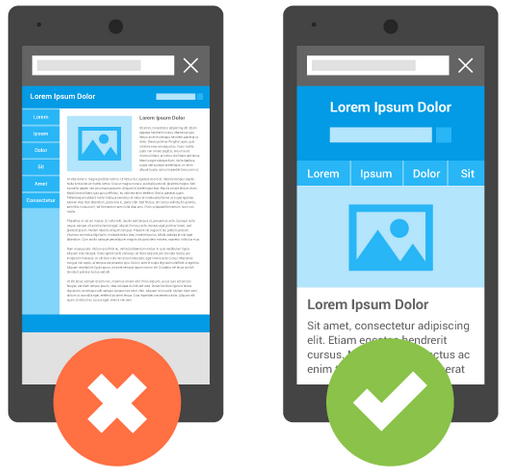
The first step for rating page quality on mobile is to understand the needs of mobile users: which is to complete their task quickly and conveniently. These raters are given a list of queries to type (or speak) and then judge the landing page results.
Google has dedicated an entire section of mobile optimization in the guide, which I will sum up in a few bullet points below:
Great content isn’t enough, so be sure that your entire website is optimized for mobile users. If you haven’t already, this should be crucial enough to tell you that it needs to be a priority.
We already know that user intent is critical to SEO. In the guide, Google further subdivides the queries into the following user queries:
In order to be considered as this category of a query, the search topic cannot be too complex or have many potential answers. Essentially, the user is searching because they want to know more about something. Many controversial topics are considered the Know Queries because there are two or more widely diverging opinions on the subject that usually cannot be answered in one or two sentences.
[Justin Timberlake],
[Shangri-La Hotel],
[Antman]
Another aspect of this query you ought to know is Know Simple Query. It is slightly different than the Know Queries.
As a rule of thumb, it would fit in 1-2 sentences or a shortlist of items. These comprise of questions with a clear answer.
[Justin Timberlake Age],
[Shangri-La Hotel Rooms],
[Antman Release Date]
This is especially important if you want to get your web page featured in one of Google’s featured snippets which contain most of the necessary information.
This is a query made to accomplish a goal or activity which may either be to buy, download, interact with an app on a phone. Users want to do something.

A special kind of Do query is the Device Action Query. That means to do something on our device such as open an app, send a text, or view a picture.
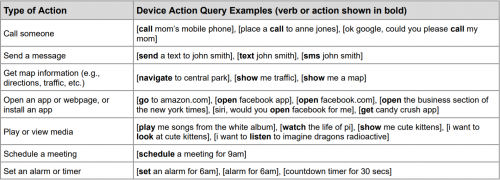
These results are highly personalized to the user as the query usually has a clear action word and intent.
Website Query indicates that the user is looking for a specific website or webpage. These can be direct queries with a perfectly formed URL such as:
However, these can also be imperfect URL queries: Queries that look like URL queries, but are not “working URLs”. These URLs do not load if you type or paste them in your browser address bar.
Visit-in-person Queries are made by users looking for a specific business or organization. These are search terms that suggest users will make a physical visit to a real-world location.
Using Google’s Guidelines, here are some of the examples:
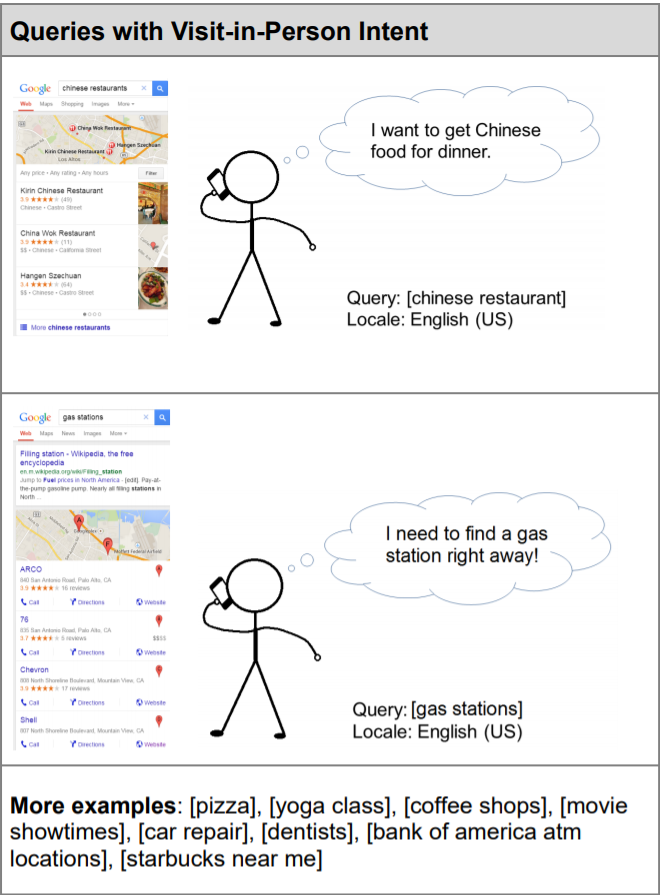
Because mobile phones are often used for Visit-in-Person queries, make sure to consider visit-in-person intent as a possibility for mobile phone users.
It is not something new that page quality is being emphasized by Google in order to be categorized as a good page or site. In fact, it is widely accepted by the public that having a quality page that delivers true values is the essential element to excel in the SERP ranking competition.
The verdict is, how we view the quality of a page might be different from how Google views it. Here, we are going to reveal the guidelines Google uses to rate the overall quality of a page.
A website shall be created with a true or beneficial purpose to deliver specific value to its visitors. The better the experience and usefulness of a website provided to the visitors, the higher the page quality will be rated.
When we talk about main content quality, high-quality main content must be factually accurate for the topic which is supported by expert consensus. It’s also about the page features and functionality to fulfill the needs of the topic.
Google trusts a site when its users trust it. Having clear and satisfying website information, as well as information of the person who is responsible for the website is crucial. Users feel comfortable and will trust a site when information is visible. The same goes to the website and site owner’s reputation.
A low quality page might have a true or beneficial purpose, but fails to achieve it within its page. If a page posses the following characteristics, it will be rated as a low quality page by Google:
Compare to high-quality pages, it’s much easier to be rated as a low-quality page if any of the above mistakes is being done and practiced.
As discussed previously, lacking E-A-T is killing the quality of a page. In addition to that, the absence of high-quality main content, unsatisfying amount of the main content will also bring your page quality rating down by Google.
Well, Google is aware that many sites are established with a certain degree of monetization and also to serve additional purposes, such as ads and supplementary content. There is no wrong in doing it. But if the ads and supplementary content are being designed in a way that it distracts the users from the main content, then it will affect the quality rating of a page heavily.
In addition to that, having mixed or mildly negative reputation on a website or the creator of the main content will cause the page to be rated as low quality. Unfortunately, many websites have little reputation information. Here’s what you can do, find more relevant reviews and rating to display on your site, a few negative customers reviews are perfectly fine. More details on the next chapter.
Last but not least, a website should have sufficient amount of information about the website as well as the creator of the website. For a personal website, an email address or social media links would be sufficient. A larger website that involves financial transactions would require more information to achieve a higher level of trust, these include customer service information, person-in-charge contact information and more.
One of the most significant additions that we can see in the guidelines this year was the creator’s reputation. Instead of just looking at the reputation of the website, the Google raters have to also identify the reputation of the creator of the main content too if applicable.

It is not about how websites or creators describe their expertise and authority but how reputable external sources agree with what the website says.
According to Google, the reputable external sources that provide independent reputation information about the website or creator may include the following:
*Customers’ reviews can be helpful for assessing the reputation of the business too but the Google raters are advised to try to find as many reviews as possible when interpreting them.*
Reputation is an important factor to be considered when using the High rating and informs the E-A-T of the page. For example, the high rating cannot be used for any websites that has a convincing negative reputation.
When you have only one creator for the entire website, creating a short bio and then a link to a full author page that includes information such as their credentials or experience will be an added advantage.
But in the cases where you have more than one creators, it will cause some challenges to show the expertise for each one of them.
In the Needs Met Rating Guideline section, the Google raters were asked to evaluate how helpful and satisfying the result is for mobile users.
The rating consists of five levels, from “Fully Meets” all the way down to “Fails to Meet”:
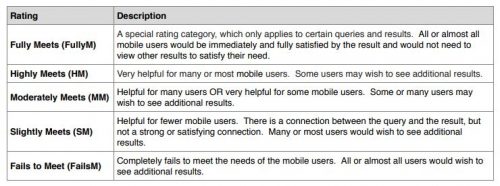
This rating helps Google to understand how search queries are related to user intent, and how helpful is the search results to them.
For example, if there are a lot of low-quality pages that ‘Fails to Meet’ users need showing up for certain query, Google obviously needs to work on delivering better and more relevant results for that particular query.
As website owners, it is important to make sure that your site is able to answer the searches that the searchers made and is relevant and useful to them. Getting a large amount of traffic but a high bounce rate can be one of the signals that you need to look back at your content.
To achieve the highest level of “Fully Meets”, the following must be met:
Let’s imagine this situation, a high-quality page with detailed information about acoustic guitars is useless to you if you actually want information about violins. If you searched for “violin” but the search results are showing pages about acoustic guitars, your search needs is definitely unfulfilled.
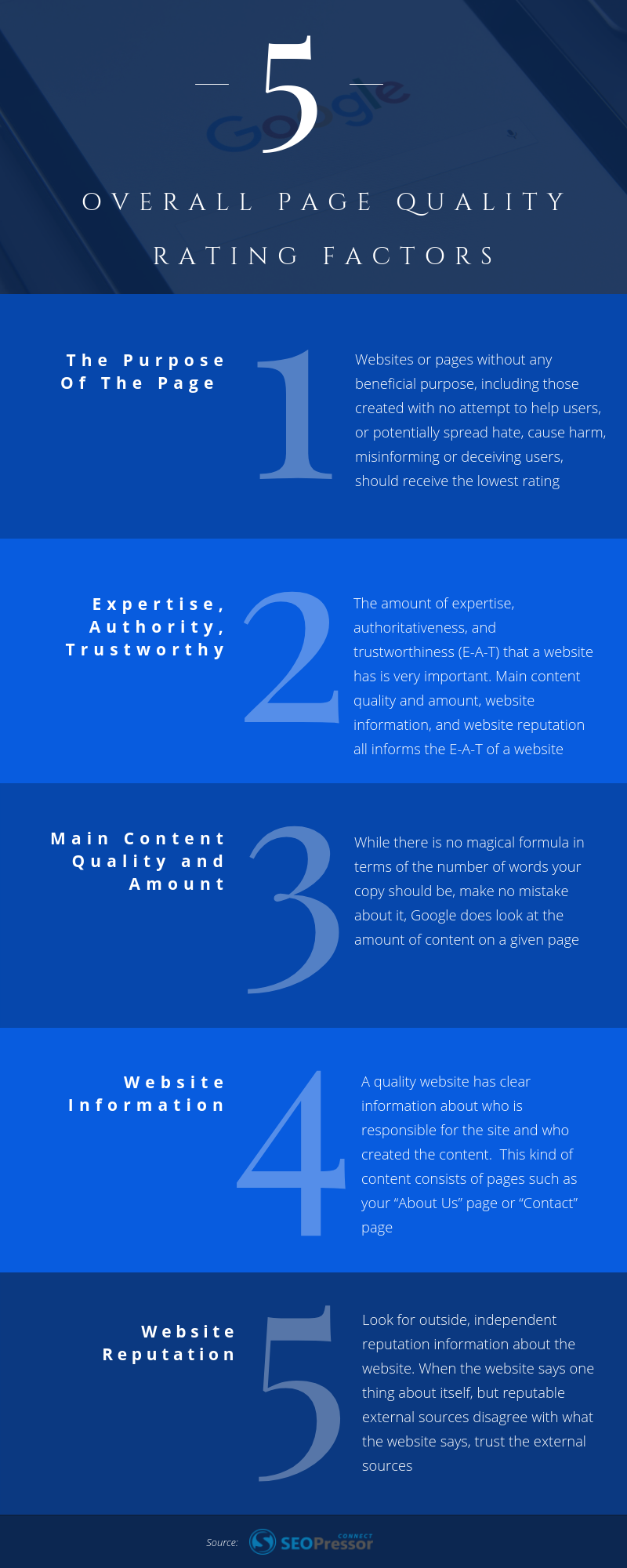
The following are the main factors that are being considered when deciding the overall Page Quality rating:
When creating the next content, always ask yourself ‘How can my readers benefit from this post’. Because pages that don’t serve any beneficial purpose will ultimately receive the lowest rating and you surely don’t want that to happen.
Once again, Google’s quality ratings will not impact your site’s ranking directly in the search results. But it is always worth taking note that Google does use these ratings to ensure searchers get the most relevant and useful search results.
And that’s it! Hope that’s not a lot to digest? I’m looking forward to hearing your thoughts in the comment section below.
The very first time Google released its Quality Rater Guidelines was in 2015. Quite recently in 2018, they have done a major core update to the guide.
So here we will list down what has changed, and important tips for you to take away from the guide to incorporate into your own sites.
Google updated its Search Quality Rater Guidelines on May 16, following its last update in July 2018.
What’s new?
This time, the updates add two pages covering guidelines on content expertise and interstitial pages while lumping E-A-T in with page quality. These revisions, however, do not reflect any great alterations on how quality raters evaluate websites.
In July 2019, the Google Search Quality Rater Guidelines have been redirected to a new URL. Click here for the new URL.
It is important to note that it’s different from the Google’s search ranking algorithm which focuses more on the mechanics of getting your website on the first page of SERP (keywords, headlines, backlinks, etc).
Also always be reminded that these quality raters cannot impact your site directly in how it ranks in the search results. But Google surely uses them to ensure the best search results are shown with the highest quality sites ranking first.
To conclude, here’s an overview of the 9 important takeaways summed up in the Google Search Quality Rater Guidelines:
Have you seen the Google Search Quality Rater Guidelines signals above impact your own Google ratings? Do share your experiences below!
Updated: 6 December 2025


Save thousands of dollars (it’s 100x cheaper)

Zero risk of Google penalty (it’s Google-approved)

Boost your rankings (proven by case studies)
Rank High With This Link Strategy
Precise, Simplified, Fast Internal Linking.
